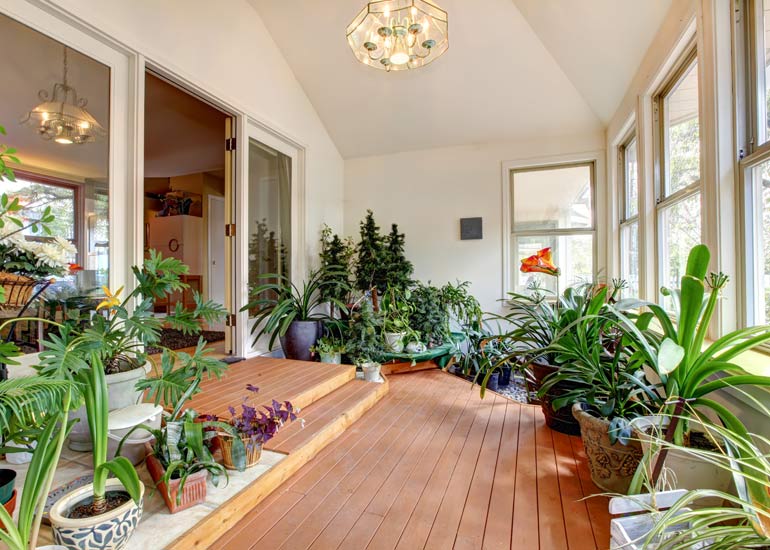
How to grow house plants
In recent years house plants have had a renaissance, storming their way into stylish, designer interiors.
How to grow house plants
In recent years house plants have had a renaissance, storming their way into stylish, designer interiors.
Forget those memories of the 1970's, where a spindly spider plant on your bookshelf was perfectly acceptable - today's trend is for carefully placed, well grown houseplants that provide a strong design element such as texture, colour or an architectural focal point.
Many house plants have practical benefits too, helping to purify the air by removing toxins and reducing carbon dioxide levels. Many studies have shown that a little interior landscaping can greatly improve your well being by lowering stress levels and reducing noise.
If your home could be turned into a plant paradise then read on to learn how to grow house plants. Why not browse our extensive range and buy your houseplants online today? Take a look at our Top 10 House plants for some inspiration. And for growers advice and help choosing the right indoor plant for your home, head over to our houseplant hub page.

Choosing the right house plants.
House plants come in all shapes and sizes, and they each have their own individual requirements. While this means that there is a plant for almost every spot in your home, it also means that you'll need to do a little research before you buy. There's no need to panic - simply ask yourself the following questions...
Question 1: Where would you like to grow a house plant?
The most important things to consider are light, temperature, humidity and available space. This will help you select the perfect plant for the perfect position.
Light:
South facing windows provide hot, brightly lit conditions enjoyed by fleshy-leaved Senecio and other succulents or cacti. North facing positions are much cooler, offering light shade, away from the direct glare of the sun - perfect for Aspidistra elatior. East and west facing positions are suitable for quite a wide range of plants that enjoy bright light, but dislike scorching hot sun. Bromeliads, Orchids and Arum Lilies to name just a few.

Temperature:
A hot, south facing position will need something capable of withstanding the scorch of direct sun. Yucca elephantipes would make an ideal floor standing plant. Whereas a hallway table, susceptible to draughts from a well used doorway, will need something tough that can withstand rapid changes in temperature - Sansevieria trifasciata var. laurentii perhaps?
Humidity:
Humid locations such as the kitchen, bathroom or conservatory will provide good conditions for some of those moisture loving, tropical plants such as Calathea. Radiators in warm centrally heated living rooms can create a much drier environment that is better suited to plants such as Cycas revoluta.
Available space:
Choose a plant to suit the space available. Quick growing Monstera deliciosa is perfect for a filling a large empty corner, while a trio of Crassula in terracotta pots make a great feature for a narrow windowsill. A vertical space can be filled with Epipremnum aureum, trained onto a tall moss pole. You can even create a cascade of foliage from a hanging basket - Chlorophytum makes a good choice!

Question 2: How much time do you have?
Consider plant care including feeding, watering, cleaning and repotting.
Water and fertiliser:
Are you a busy or forgetful person? If so, choose a low maintenance plant that needs little water/ feed and tolerates occasional drought, such as Zamioculcas zamiifolia. Those who have the time to nurture their plants may opt for something more challenging - a carnivorous plant or a Bonsai tree maybe?
Cleaning:

The large, glossy leaves of Philodendron look spectacular, but they will collect dust over time which will need to be removed. Regular wiping with a damp cloth will keep them looking at their best. If this all sounds like too much effort go for something, such as Polyscias balfouriana - the dust won't show so much against its small, variegated leaves.
Repotting:
Many house plants will benefit from repotting every two years, especially fast growing species such as Tradescantia. If you prefer a slow growing specimen that will happily wait a little longer, then Ficus benjamina may suit you better. Some plants even prefer to be a little pot bound - Easter Cactus for example!
Question 3: What sort of house plant display would you like?
Individual focal points:
A bold specimen plant with strong architechtural lines will create an instant focal point for a room. Dracaena, Yucca and Zamioculcas all offer sharp, angular lines while Monstera and Philodendron create a lush, jungle feel.

Grouped displays:
A group of house plants can be most effective for adding contrast, texture and atmosphere to a room. Plants which are unremarkable when grown on their own can bring significant interest as part of a grouped display. Aim for a complimentary range of leaf shapes, texture and colour. Grouped displays work best where the plants require similar growing conditions.
Colour:
Colourful house plants are particularly useful for adding a contrast to the clean lines and neutral tones of contemporary rooms. The bright blooms of many Orchids make the perfect accessory for a warm, bright living room. Colourful foliage is equally effective - Calathea, Codiaeum and Cordyline 'Tango' all provide a bold splash of colour that will instantly enhance your living space.
Top tips for growing house plants.
Avoid positions close to radiators and cold draughts.
Some plants dislike the chemicals added to tap water. Use tepid, rainwater or distilled water instead.
Drain plants well after watering - avoid leaving them in standing water.
Humidity can be increased by spraying with a fine mist or standing pots on a pebble tray filled with water.
Keep an eye out for pests such as aphid, mealy bug, spider mite and scale. Treat with an appropriate insecticide if necessary.

Written by: Sue Sanderson
Plants and gardens have always been a big part of my life. I can remember helping my Dad to prick out seedlings, even before I could see over the top of the potting bench. As an adult, I trained at Writtle College where I received my degree, BSc. (Hons) Horticulture. After working in a specialist plantsman's nursery, and later, as a consulting arboriculturalist, I joined Thompson & Morgan in 2008. Initially looking after the grounds and coordinating the plant trials, I now support the web team offering horticultural advice online.Sign Up For Exclusive Special Offers




© 2025 Thompson & Morgan. All rights reserved. A division of Branded Garden Products Limited.




